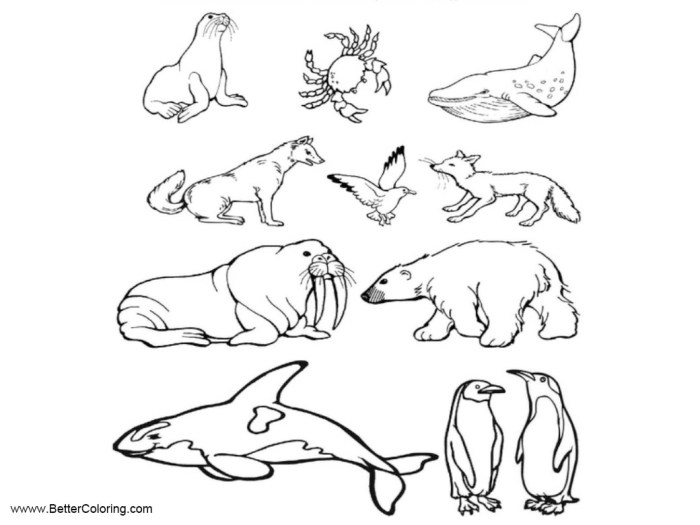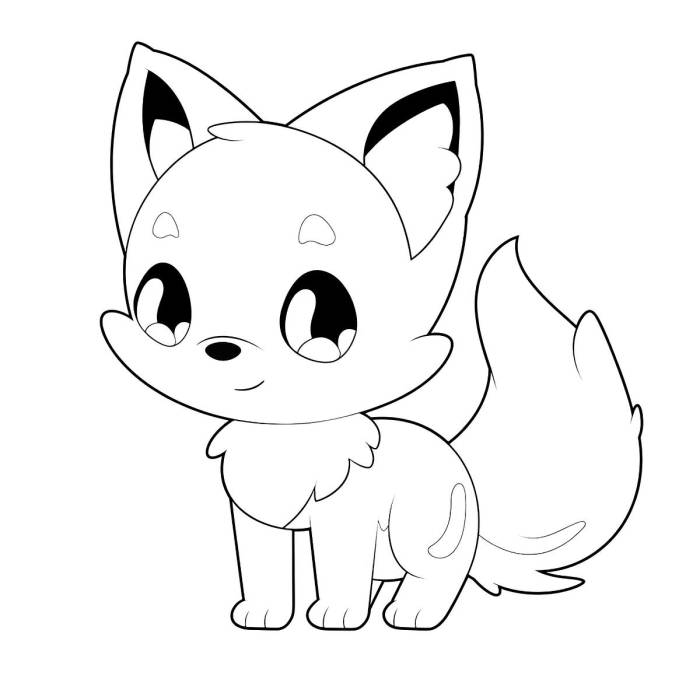Arctic Animal Overview

Arctic animal coloring page – The Arctic, a land of ice and snow, is home to a fascinating array of animals uniquely adapted to survive its harsh conditions. These creatures, with their striking appearances and remarkable adaptations, make for captivating subjects in coloring pages, offering a blend of education and artistic expression. This overview will explore several key Arctic animals, highlighting their physical characteristics, habitats, and behaviors.
Polar Bear Physical Characteristics, Habitat, and Behavior, Arctic animal coloring page
Polar bears (Ursus maritimus) are arguably the most iconic Arctic animals. Their thick, white fur provides exceptional camouflage against the snow and ice, crucial for both hunting and avoiding predators. Beneath this fur lies a thick layer of blubber, providing insulation against the freezing temperatures. Polar bears possess large paws with rough pads and non-retractable claws, providing excellent traction on ice and snow.
They are apex predators, primarily feeding on seals, which they hunt by waiting near breathing holes in the ice or by ambushing them on land. Their habitat encompasses the Arctic ice caps and surrounding coastal regions.
Arctic Fox Physical Characteristics, Habitat, and Behavior
Arctic foxes (Vulpes lagopus) are small, agile canids with incredibly dense fur, offering superb insulation in the frigid Arctic climate. Their fur changes color seasonally; white in winter for camouflage and brown or grey in summer for better blending with the changing landscape. Their small, rounded ears minimize heat loss. They are opportunistic omnivores, feeding on lemmings, birds, eggs, and carrion.
Arctic foxes inhabit the tundra and ice plains, often creating burrows for shelter.
Penguin Physical Characteristics, Habitat, and Behavior
While not strictly Arctic animals (they are found primarily in the Antarctic), penguins are often associated with polar regions and are frequently featured in Arctic-themed coloring books. Penguins are flightless birds with streamlined bodies, perfect for swimming. Their dense feathers and thick layer of blubber provide insulation. They have webbed feet for propulsion in water and powerful flippers for swimming.
Different penguin species inhabit various regions of the Antarctic, with their diet consisting mainly of fish, krill, and squid.
Walrus Physical Characteristics, Habitat, and Behavior
Walruses (Odobenus rosmarus) are large, marine mammals with prominent tusks used for defense, hauling themselves onto ice floes, and finding food. Their thick blubber layer provides insulation and buoyancy. They have a wrinkled, leathery skin and powerful flippers. Walruses primarily feed on benthic invertebrates, such as clams and worms, using their tusks and sensitive whiskers to locate prey on the seafloor.
They inhabit Arctic coastal waters and ice floes.
| Animal | Habitat | Key Feature | Coloring Suggestion |
|---|---|---|---|
| Polar Bear | Arctic ice caps and coastal regions | Thick white fur, large paws | Varying shades of white, with subtle hints of cream or yellow |
| Arctic Fox | Tundra and ice plains | Dense fur (white in winter, brown/grey in summer) | White for winter, brown/grey for summer; consider black accents for nose and eyes |
| Emperor Penguin | Antarctic ice | Streamlined body, black and white plumage | Sharp contrast of black and white; add subtle grey tones |
| Walrus | Arctic coastal waters and ice floes | Prominent tusks, wrinkled skin | Dark grey or brown skin, with ivory-colored tusks |
Artistic Considerations: Arctic Animal Coloring Page

Creating engaging and effective coloring pages for Arctic animals requires careful consideration of artistic style, color palettes, and line techniques. The chosen approach significantly impacts the final product’s appeal and its ability to capture the essence of the Arctic environment and its inhabitants. A well-designed coloring page should be both visually stimulating and encourage creative expression from the user.
Artistic Styles for Arctic Animal Coloring Pages
The choice between a realistic and cartoonish style significantly influences the overall aesthetic. A realistic style aims for accuracy in depicting the animal’s anatomy, fur texture, and coloration. This approach often involves detailed linework and shading to create a sense of depth and realism. In contrast, a cartoonish style prioritizes simplification and exaggeration of features, creating a playful and approachable image.
This style often uses bolder lines, simpler shapes, and vibrant colors. The choice depends on the target audience and the desired mood; realistic styles might be more suitable for older children or adults interested in nature, while cartoonish styles are often preferred for younger children.
Effective Color Palettes for Arctic Animals and Environments
The color palette is crucial in establishing the mood and atmosphere. For Arctic animals and their environments, a limited palette emphasizing cool tones is generally most effective. Shades of white, light blues, grays, and icy pastels effectively represent the snow, ice, and cold temperatures. For animals, incorporating muted browns, whites, and blacks for fur and incorporating subtle hints of warmer colors for accents can add visual interest without overwhelming the cool palette.
Consider using variations in saturation and brightness to create depth and visual interest, such as using a darker shade of blue for shadows to suggest depth in the icy landscape. For example, a polar bear’s fur might be rendered using varying shades of white and cream, with touches of light gray for shading.
Line Weight and Texture for Depth and Visual Interest
Line weight and texture play a significant role in creating depth and visual interest. Varying line weights can add emphasis to certain features, such as the animal’s eyes or paws, making them stand out. Thicker lines can create a sense of weight and solidity, while thinner lines can suggest delicacy and lightness. Texture can be suggested through cross-hatching, stippling, or other line techniques.
For example, cross-hatching can effectively depict the thick fur of a polar bear, while stippling can suggest the smoothness of ice. The use of different textures, such as fine lines for smooth surfaces and heavy lines for rough textures, can add realism and detail to the coloring page.
Creating a Simple Arctic Fox Illustration
To create a simple arctic fox illustration, begin by sketching basic shapes. Start with a circle for the head, an oval for the body, and two smaller circles for the ears. Add triangles for the fox’s nose and smaller ovals for the paws. Use simple lines to connect these shapes, creating the fox’s silhouette. Refine the lines to create a more defined shape, adding details such as the fox’s eyes, mouth, and tail.
Remember to vary the line weight, using thicker lines for the Artikels and thinner lines for details. Finally, consider adding simple textural elements, such as short, closely spaced lines to suggest fur. This approach simplifies the process, making it accessible to those with limited drawing experience.
So, you’re into arctic animal coloring pages? Polar bears and penguins, right? But sometimes you need a cuteness overload, like those found in kawaii animals coloring pages , before jumping back to the icy landscapes and majestic creatures of the Arctic. Seriously, that adorable overload helps appreciate the raw power of a polar bear even more, you know?
Back to those frosty coloring adventures then!


